

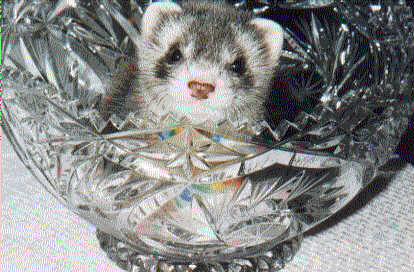


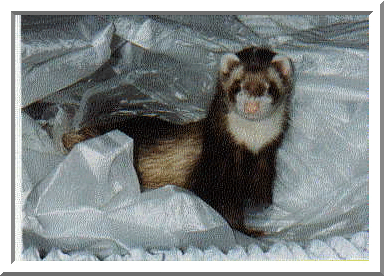
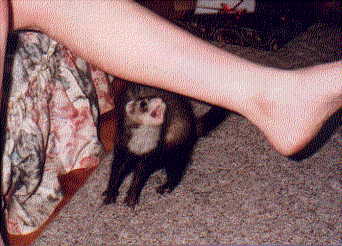

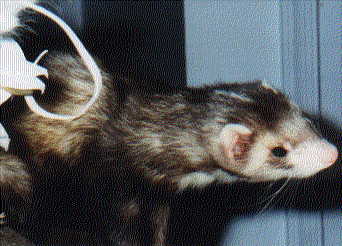
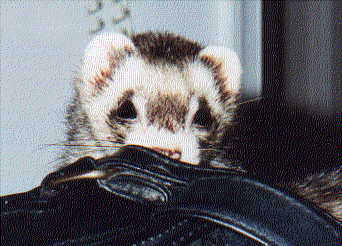







As with all training, patience is the keyword along with repetition and love. The treat you use could be a little lick of Ferretone from your finger, a piece of raisin cut into thirds, or a small piece of anything your ferret loves.
The easiest way to train is in a confined area so there are no distractions. This is easily accomplished in the cage. Put a litter box in one side of the cage making sure one side is low so your ferret can easily get in and out. When cleaning the box always leave a little poop behind so they are able to smell that this is the area. If your ferret is not even cage trained, just decrease the size of the area so he has his choice of a place to eat, sleep and go to the bathroom. Generally a ferret will not go on his bedding or where he eats.
When a ferret first wakes up this is generally when he will have to use his box. If you take him out of his cage too soon he will not have this chance, that is why it is easier to wake him up and watch what he does. Be patient it might take awhile. So just watch him as you repeat "go to your potty", even though he wants to rush out just keep this up until he uses the litter box. Once he does what you want, let him out immediately, pick him up praise him, and give him a "small" treat. They generally catch onto this pretty fast. Have another litter box outside his cage. Occasionally pick him up and put him in the litter box. If he uses it, pick him up and praise him and give him a treat. As he is playing watch him carefully for any signs of backing up, the moment you see this it will tell you "grab him quick" and put him in the "outside" litter box. Do not let him run off until he has done his business. Then again pick him up and praise him and give him a "small" treat. The treats must be "small", because you will be using them a lot, and if you give too much he will tire of it. As long as he is out of the cage you must watch him, if he has an accident it was because you weren't doing your job, and he did what is natural for him.
As he gets better and starts running to his outside litter box, expand the area he is allowed to roam in, this may also mean adding another litter box area. As you add the litter boxes you must keep showing him where they are, it will take awhile.
When they are young they're easily distracted and forget, so you need to be there to remind them. Don't expect him to be 100% litter trained, accidents will happen, but there is no reason he shouldn't be at least 95% litter trained depending on how well you have helped to train him. At first it will take a lot of your time but in the end it will save you cleaning up lots of accidents. Once they get the idea of what you want, and know they get treats it will be easy, but you must be there watching and ready to give a treat.
I would say the average room probably needs two litter boxes plus the one in the cage, when they are young. As they get accustomed to the idea and older, you can cut down if necessary. Be careful as to where you place the pans it must be close to where they play and easily accessible, and also in an area that may be permanent, as they seem to imprint on the location, and changing it may be difficult later. When the ferret is not out of the cage these pans can be stored away out of sight.
I use throw away, smaller then litter pan size, aluminum trays when first training. You can almost push down the access side to the floor.
If he has an accident, and you haven't caught him in the "act", there is no sense in punishing him with a "time out" because he probably won't know what he did. If you catch him in the "act", let him finish and put him in his cage for a "time out", as you are putting him in the cage put him directly in his litter box. You can say in a louder then normal tone while the accident is happening "NO", and also reinforce this as you are putting him in the cage. A minute or two is the most for a time out, allowing you time to clean up.
Have a spray bottle with water and vinegar and some paper towels handy. As you bring him out of the cage put him into the litter box ( not expecting him to go) and say in a softer voice "good boy" (girl). no treat at this time. A cuddle and praise will have to do. Treats are only given when something is done in the right place. If you are consistent with this, and are there to watch, litter training should be easy. If you let him out and let him do what is natural for him by making mistakes, then breaking him of this habit will be very difficult and take a longer time.
Take the time and you will be well rewarded with nothing to clean up. Just remember those treats never stop, even after training you can occasionally give him one when you see him in his litter box. Don't forget the praise and cuddles!!!
When they are younger they seem to go more frequently then when they are 2 years old.If you spend time watching you will get used to your ferrets bathroom habits.
Do not feed them when you first bring them out of their cage, save this for when they go back in. This way they will have their meal to calm them down from the excitement of being out. I like surprising them and waking them up at different times, you'd be shocked at how quickly can they can adapt to your schedule.
The best place to train them is in a room with no carpeting, I think the kitchen is what I found to be the easiest. I could watch what was happening and get work done at the same time. If you choose this room just make sure you block off access to the back of the refrigerator!!
I think this method is good for any age ferret. I also think knowing your ferrets bathroom habits is crucial to their well being. Lack of stool, frequent urination, color of stool, and diarrhea are all things that could point to a health problem and the quicker this is observed the better it will be for your ferret as well as you. Read and have a general knowledge of these things, as well as all basic health issues that may occur with a ferret.


